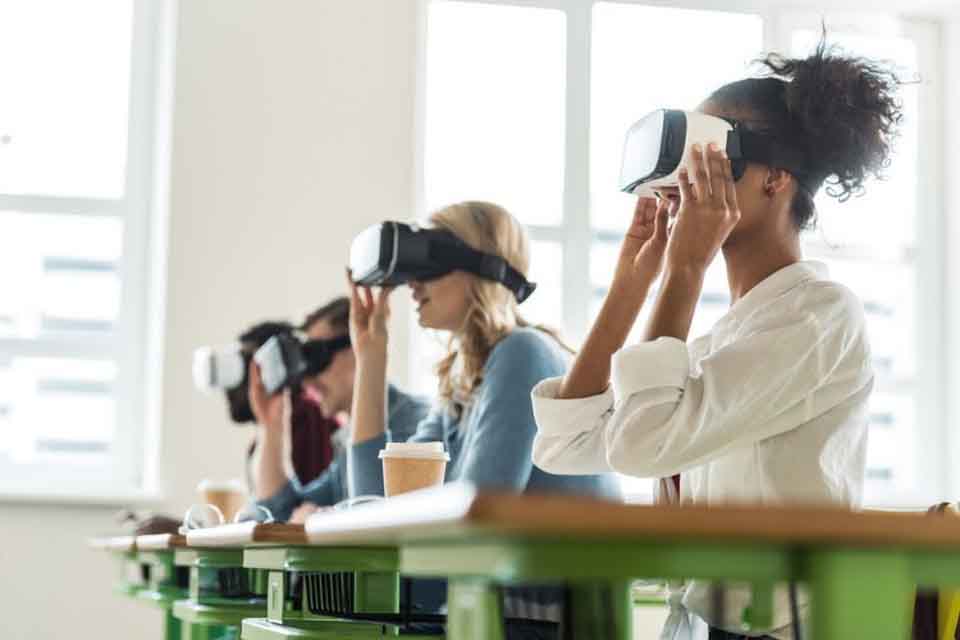You’re a new instructor teaching a US history lesson when two students start arguing. On your virtual reality (VR) headset, possible reactions pop up: call another teacher for help, wait for the moment to pass, or raise your voice until you get the students’ attention. In real time, you can choose a course of action and see your response play out with student avatars. You discuss your decision later with your education professor to assess your performance in this virtual classroom scenario. Scenarios like these are the future of teacher training.
This example may sound far fetched, but VR scenarios like these may be the future of teacher training. When used in conjunction with traditional training methods, simulation technology is a valuable resource for improving teacher preparedness and can also be applied to teacher development in programs like American University’s Doctorate in Education Policy and Leadership program to help classroom instructors improve and learn new techniques.
The Benefits of Using Simulation Technology for Teacher Development
Traditional teacher training methods have certain limitations. A student teacher may spend three or four months in a classroom and, depending on the class, never be exposed to a high-stakes scenario like breaking up a student conflict.
That’s where simulation technology comes into play. VR technology transforms teacher training by creating virtual classroom scenarios in which teachers can practice reacting to challenging situations and become more confident in front of a live classroom. Simulation technology also offers new opportunities for teacher development, since teachers can use specialized 360-degree cameras to observe their own teaching styles.
The benefits of simulation technology on teacher development fall into two main categories.
Real Classroom Exploration
An essential part of teacher development is taking the time to observe, critique, and refine one’s teaching style. The traditional way to do this is to record a lesson from start to finish, but conventional cameras only capture flat, 2D videos that place all the focus on teachers and neglect to capture students. New cameras with 360-degree image capture record immersive environments that bring students into the picture and allow teachers not only to observe themselves, but also to see how different students react to their lesson approach. These small cameras can be fixed to vantage points where they don’t distract students and can capture the entire class dynamic.
This technology lets teachers witness possible missteps in the way they presented a lesson as well as see where their lesson was successful and created student engagement. By analyzing these videos, teachers gain insight into the best techniques for engaging their students and can refine their teaching strategies accordingly.
Virtual Reality Simulation
Simulation technology has brought about the arrival of virtual classrooms. Using a VR headset, this invaluable resource displays lifelike student avatars using 360-degree videos that make teachers feel as if they’re in a real classroom. The avatars’ behaviors can be programmed in a variety of ways to create a range of classroom experiences.
Virtual classrooms also provide a great deal of flexibility in terms of design. Teachers who want to focus on improving their classroom management skills can practice with student avatars that simulate those with special needs, such as autism or a learning disability, or avatars that tend to be rowdy and disturb the class.
On the other hand, if teachers are intent on practicing specific content or improving their lesson delivery, they may program their virtual classrooms to have calm, courteous student avatars. In VR simulations, classroom settings can be refined in any number of ways to aid teacher development in specific concentrations.
A Powerful Tool for Teachers, Students, and Administrators
VR presents many opportunities for teachers, students, and school administrators. For students, VR can help block out distractions, improve focus and concentration, and increase engagement. For example, VR technology creates opportunities to travel outside of the classroom without ever having to leave their desks. They can explore new countries, interact with people from different cultures, and even visit the surface of the moon or the bottom of the sea. Additionally, students may use VR to practice teamwork, collaboration, and problem-solving skills in a low-stakes setting.
Simulation technology is also a helpful tool for administrators. By using VR, administrators can practice giving parents feedback during parent-teacher conferences, finding the best ways to deliver sensitive information in a way that will be well received by parents.
The opportunities afforded by simulation technology offer significant benefits to classrooms and teacher development, but they shouldn’t be thought of as replacements for real-world classroom experience. Instead, technologies such as VR should be considered a helpful tool to enhance learning experiences for students, teachers, and administrators. By giving teachers a platform to build classroom confidence and refine their teaching skills, simulation technology paves the way for effective teacher training options, which in turn leads to improved student outcomes.
Lead the Future of Education
Simulation technology’s rise in the field has created a number of exciting prospects in education and will continue to offer innovative opportunities. VR is just one of the latest technology-based practices that make up the core component of American University’s Doctorate in Education Policy and Leadership program. The program equips graduates for success in a rapidly changing educational landscape through courses such as Exercising Conscious Leadership, which challenges students to engage in reflection and self-critique to develop the awareness to engage in the highest practices of educational leadership.
Learn more about how American University’s Doctor of Education program prepares you to be part of the next generation of education innovators.
District Administration, “How Virtual Reality is Changing the Game of Teacher Training”
EdTech: Focus on K-12, “AR/VR in K-12: Schools Use Immersive Technology for Assistive Learning”
The Digital Teacher, Teacher Training with Virtual Reality
The Journal, “Making Virtual Reality a Reality in Today’s Classrooms”

